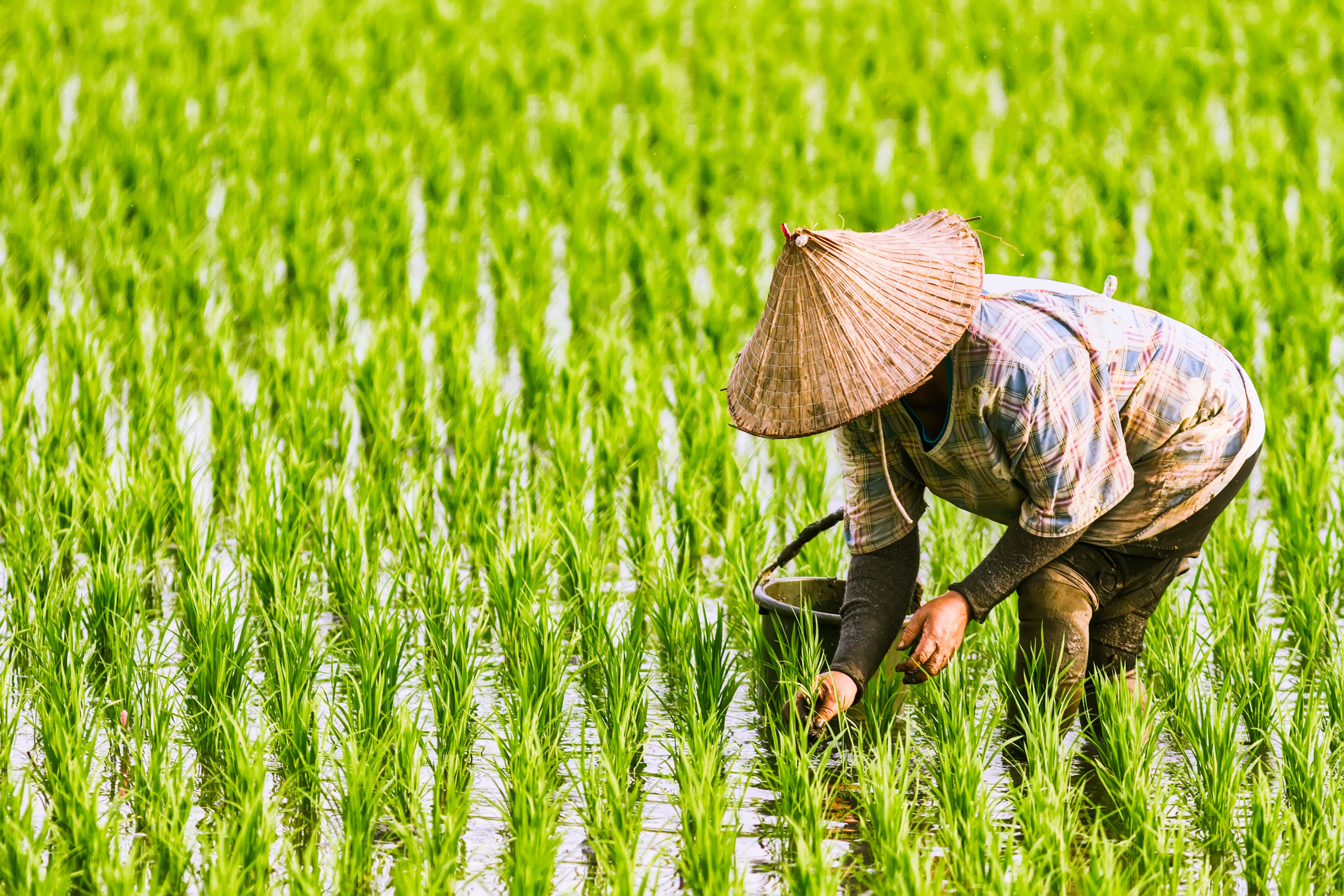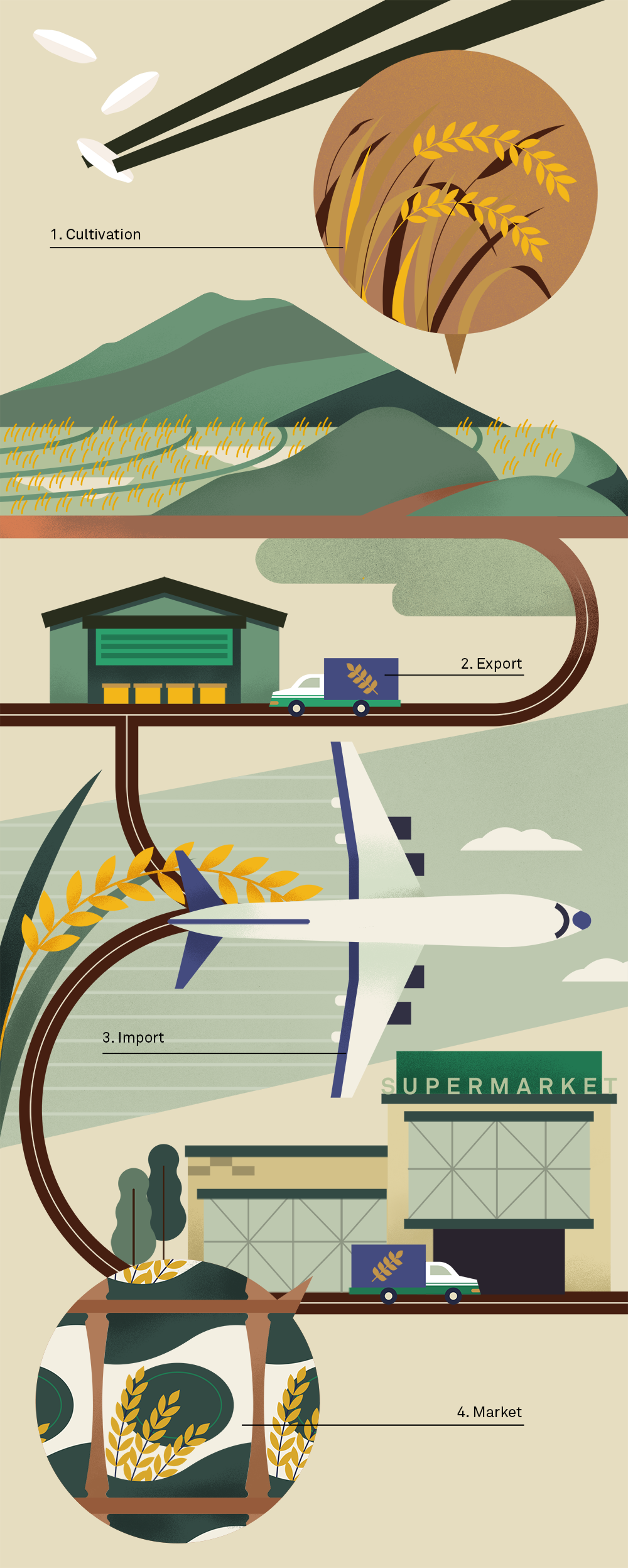
How does rice get to your plate?
by Kirana Soerono
More than 3.5 billion people depend on rice for sustenance, and 90 percent of the global rice consumption comes from Asia. In many Asian cultures, rice is synonymous to food—it is considered that if one has not eaten rice, then one has not eaten at all. In Japanese, for example, breakfast, lunch, and dinner are described as asa gohan, hiru gohan, and ban gohan respectively. All three meals share the term gohan—which means rice. The grain is an irreplaceable part of every meal.
Therefore, for many countries, rice shortages and the subsequent price increase—such as one caused by the 2007–2008 food crisis—would draw a panicked response. The grain has immense political importance that a good or terrible rice security policy could make or break a politician’s career. An important part of a nation leader’s job is to ensure that enough rice gets to everyone’s plates.
So, how does rice get to your plate?

Harvested rice
Let us start with what rice exactly is. There are two major types of rice: the Oryza Sativa (from Asia) and the Oryza Glaberrima (from West Africa). The more common type, the Oryza Sativa, is also divided into two major subtypes: the Indicas and the Sinica Japonicas. There are also three major rice varieties: long grain, medium grain and short grain.
What about brown and white rice? They actually come from the same type of grain, but are processed differently. White rice is the result of having its husk, bran, and germ removed. Whereas brown rice has only its husk removed from the grain, leaving the bran and germ layers intact. The bran and germ layer gives it a nuttier taste and a chewier texture, and retains more nutrients.

Anatomy of a rice grain
Today, white rice remains as the popular choice, although more health conscious individuals (usually in wealthier markets) are starting to make the switch to brown rice. For every 100 grams of white rice, there are 6.3 grams of protein and practically no fibre. While for every 100 grams of brown rice, there are 7.2 grams of protein and 3.2 grams fibre.

A woman works in a rice paddy field
China is the world’s largest producer of rice. However, countries like Japan, Australia, and the United States produces some of the highest yield per hectare with six tons of rice per hectare. Outside of these countries, many Asian farmers produce only two tons of rice per hectare. About 50 percent of rice farmers in Asia harvest rice twice a year, and plant non-irrigated crop like pulses and bean in between the two rice planting seasons.
High yields depend on soil and water condition, fertilizer (natural or artificial) and pest control. Some farmers use insecticide to control pest, but many traditional farmers use fish. Another way to increase yield is through means of mechanisation. Mechanisation of cultivation advanced furthest in the United States.
Why are there not more farmers using mechanisation process?
The first reason is because mechanisation is expensive, and the cost is only justified where control of water supply is guaranteed.
Secondly, mechanisation saves on labour costs, but it does not necessarily increase the number of yields per hectare. Yield increase still depends on cultivation conditions. Furthermore, most rice in Asia came from smallholder farmers whose paddy fields are too small to justify the investment.
Global Rice Import and Export of 2016
Most rice produced in the world are consumed domestically, and only five percent of rice produced in the world enters the global market. It is a very volatile market, and its players changes every year. All exported rice are leftover rice, meaning that countries will consume as much rice as they need first before selling it abroad. This also means that countries that produce more rice are not necessarily the biggest exporters.
The search for suitable rice buyer and seller is an arduous process. So some buyers and sellers use specialist rice brokers to conduct business. Brokers earn commission on deals they arrange for clients. This differentiates them from rice traders, who buys, ships and sells rice from and to different regions. The shipping component is especially important because while buying and selling rice is a challenge, shipping and insurance is different beast altogether. Developing world inadequacies such as inefficient ports and broken roads adds complexity to the entire process, subsequently increasing the final rice price.
Currently, the top three exporters of the grain are India, the United States, and Pakistan. Meanwhile, the top three importers are China, the United Arab Emirates, and Benin. Indonesia is also among the top importers. It is important to note that the top exporters are not necessarily the top producer. Conversely, the top importers are not necessarily the top consumer. China, for one, produces nearly a third of the world’s total rice. All it means to be a top exporter is that the nation consumes not as much rice as it produces, allowing it to have enough leftover rice to sell abroad.
Top 3 Rice Exporters and Importers of 2016

Various countries have their own way of procuring and distributing rice. To better understand how countries manage their rice consumption, we focus on the biggest rice consumers that make up 2.9 billion people: China, Indonesia and India. If you cannot live without rice, chances are you are from one these countries.
About 60 percent of the Chinese agricultural workforce cultivates rice, but it still cannot cultivate enough to feed over one billion people. This world’s largest country by population produces and consumes about a third of the world’s total rice. The State Administration of Grain (SAG) is responsible in distributing rice nationwide, guiding the production of rice, and administering the national grain reserves. Both noodles and rice are a major part of China’s diet. When rice crops fail, noodles (made of wheat) are eaten instead of the grain. Rice is the main crop south of the Yangtze river, whereas wheat and other grains dominate the north. On average, the Chinese consumes 76.4 kilogram of rice per capita annually.
Among the top three rice consumers in the world, Indonesians eat the most rice per capita, which signifies the importance of the grain in its culture. The Muslim dominated country even has myths dedicated to a goddess of rice, known as Dewi Sri in Javanese and Balinese culture, or Nyi Pohaci Sanghyang Sri in Sundanese culture. In 2015 alone, Indonesians eat about 114 kilograms of rice per capita. In comparison, Americans only eat about 12 kilograms of rice per capita annually. Rice stock and price price stability in Indonesia is handled by the National Logistics Agency (BULOG). BULOG also conducts all the imports and exports. The agency has a network at provincial level and district levels, to ensure that enough rice gets distributed throughout the archipelagic nation’s countless islands.
India is one of the world’s largest rice producer and consumer. It is also one of the few nations that consistently has enough leftover rice, which makes it the only one among the big three to be a consistent exporter. On average, Indians consume only about 73.4 kilograms of rice per capita annually, likely thanks to alternatives such as wheat-based flatbread. Pricing and distribution of the grain is controlled by , while the procurement is handled by the Food Corporation of India (FCI).

A flowchart of the rice production process
And there you have it: a not-so-simple bowl of rice.
Kirana is a digital native with a passion for creative content strategy. She has over four years of PR and marketing experience spanning from a multinational corporation, an agile digital startup, to a creative agency. In her spare time, she binge-watches cat videos on the Internet—just like everybody else.








